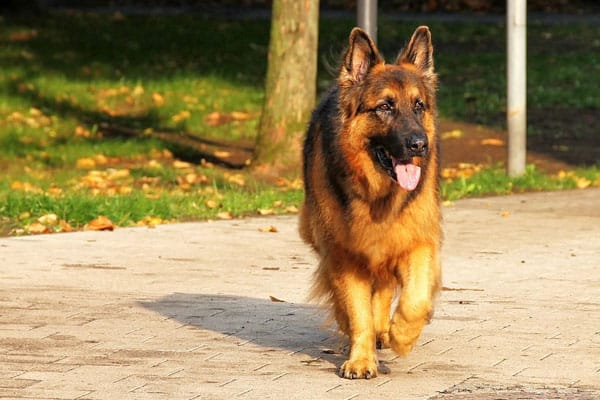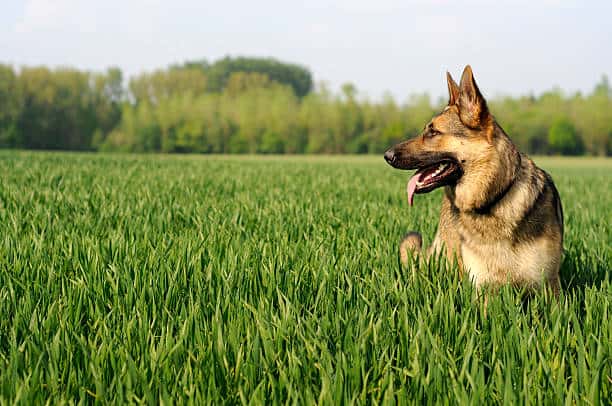Do German Shepherds Have a High Prey Drive: Insights Into the GSD Temperament
When you think of the German Shepherd, the words “prey drive” may not instinctively come to mind.
After all, the GSD is one of the two most popular companion canines in the United States today!
The idea most people have of an animal with a strong prey drive is a lion stalking their prey in the savannas of Africa, not a German Shepherd stalking a little green lizard in the backyard.
But in fact, the more you learn about the German Shepherd dog’s breed history and development, the more it makes sense that a GSD could perhaps have a strong prey drive as well.
Do German Shepherds have a high prey drive?
How high is it relative to the same in other dog breeds?
Is it something you need to worry about?
We are going to answer your most frequently asked questions about GSDs and prey drive in this article.

A Brief History of the German Shepherd Breed Development
The German Shepherd dog is currently the second most popular pet dog in all of America (second only to the unstoppable Labrador Retriever).
Knowing this, it may surprise you to learn that the German Shepherd breed was never supposed to be a pet dog at all.
Rather, the Deutsche Schäferhund breed (the German name for this dog) was always intended to be the best herding dog on the planet.
As the American Kennel Club (AKC) retells it, near the end of the 19th century, a German cavalry officer by the name of Captain Max von Stephanitz set out to create a new breed of dog to herd, guard and protect livestock.
The good captain succeeded brilliantly, but it was only a short while later that herding dogs were replaced by modern technology.
The Captain found a new job for his precious dog breed – military and police work.
Today, the German Shepherd is at the top of nearly everyone’s list for:
- personal protection
- guard dog work
- service
- therapy dog work
- farm and ranch work
- K-9 and search-and-rescue work
- as a competitor in K-9 athletics
- companion canine to families

What Is a “Prey Drive” In Dogs?
A prey drive is a fancy way of saying instinct to do something specific – in this case, to hunt or chase.
In German Shepherds, prey drive manifests in different ways.
Livestock herding and protection work
In a livestock herding and guarding, prey drive shows up as a drive to chase or herd livestock to keep the herd together and safe.
Similarly, if a predator were to approach – say a coyote or fox – the GSD’s prey drive would kick in to hunt and chase that predator away from the herd.
K-9 athletic competitions
As Lucky Shepherds German Shepherd breeder explains, even though your German Shepherd may not have much need for their prey drive instincts in the life of a pet dog, they can still put these instincts to great use in K-9 athletics.
German Shepherd dogs are incredible athletes.
They are focused, driven, and amazingly powerful. You can see your dog’s prey drive safely and wonderfully expressed through the outlet of competitive K-9 sports.
Military and police work
In a military or police work setting, the German Shepherd’s prey drive might show up most clearly when the GSD’s human partner is threatened by an enemy or when a suspect tries to escape and the German Shepherd is deployed to bring them back.
K-9 service and search-and-rescue
As a K-9 service and search-and-rescue dog, the GSD’s prey drive might be motivated when they are seeking a person who has been lost, taken, or trapped.
Also, the prey drive could be activated when the person the dog has been trained to serve and protect has a medical episode, such as seizure onset or low blood pressure.
Personal protection and companion canine
The display of the German Shepherd’s prey drive most people are familiar with happens in the context with daily family life.
Perhaps a stranger approaches the front door and your GSD grows aloof, still and wary, watching their every move.
Or maybe your kids are roughhousing with friends and your German Shepherd thinks one of “their” kids is being attacked and steps in to intervene.
Another common – and much cuter – display of prey drive happens when your German Shepherd spies a lizard scampering across the lawn or a lizard crawling up the drain spout and goes just about crazy trying to apprehend them!
So in these examples, you can see how prey drive is both a great instinct in a dog and also can be problematic or even dangerous in some situations.

The Difference Between Canine Prey Drive and Canine Aggression
As North Shore News so importantly explains, it is very easy to get canine prey drive and canine aggression mixed up.
Both can definitely occur in the German Shepherd dog as well as in many other dog breeds.
But they are definitely not the same trait.
In fact, every species that needs to eat (which is basically every species) has some level of inbuilt prey drive. Prey drive is important to be able to find and capture dinner.
This means you have a prey drive too – although yours may manifest more subtly by waiting patiently in the drive-through line at your favorite take-out restaurant.
So the prey drive is completely normal and natural.
Some dog breeds, such as the German Shepherd, do have a higher natural degree of prey drive because of the types of jobs they have been bred and trained to do.
Aggression is also normal and natural, in that it is the survival instinct at work. Aggression is one of two main forms of self-protection (the other being hiding and camouflage).
Like all species that want to survive – which again is basically all species – there are times when aggression is necessary.
But aggression in canines can also be learned and made worse when there is neglect, abuse, and other complicating life experiences.
Just as people can become more aggressive if they are teased or mistreated, so too can German Shepherds become more aggressive if their life has been difficult.
But with GSDs, they are so strong and powerful that their aggression can be very dangerous.
It is absolutely possible and one hundred percent desirable for a German Shepherd to grow up with their naturally high prey drive intact and yet have little or no tendency to display that prey drive in dangerously aggressive ways.
In other words, you want your GSD to instinctively know when you need to be protected and to do their job well, but only when it is needed.
You want your dog to be able to tell the difference between your friendly neighbor and a burglar intent on harm.
Watch as a Pro Trainer Demonstrates Prey Drive in a German Shepherd
This YouTube video from a professional K-9 trainer shows quite clearly how the German Shepherd’s prey drive looks when it is well trained and managed.
You can also see the difference between a prey drive (the instinct to hunt and chase) and defense drive, which we are not covering in this article but is an equally important trait to develop in German Shepherd dogs.
How to Handle the German Shepherds High Prey Drive Safely
As you learned at the beginning of this article, German Shepherds are amazingly popular companion canines both in America and around the world.
As K-9 Services GSD Rescue explains, GSDs are known to be loving, loyal, deeply bonded to “their” people, and steadfastly protective of and gentle with children as well as adult family members.
Who wouldn’t want to share their life with such a wonderful dog?
But it isn’t easy to train a German Shepherd from puppyhood to display the best characteristics and traits of this breed.
These dogs can be very rambunctious and destructive in puppyhood and they need a ton of exercise and activity to stay healthy and happy.
If you are new to dog ownership, be aware German Shepherds are recommended for experienced dog owners only if you plan to do your own training.
For your dog’s sake and your own sake, it is very smart to work with a professional dog trainer to make sure your German Shepherd grows up healthy and happy and well-adjusted to life in a neighborhood and family.
You will need to be prepared to train your dog multiple times per day, provide ongoing socialization to strange animals and people, give clear and consistent commands, use highly motivational positive training and reinforcement and establish firm boundaries.
All GSDs need your help to understand when you need to be protected and when you are safe and your dog can be at ease.
Are you living with a German Shepherd with a high prey drive? How do you help your dog manage this drive safely?






























